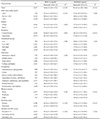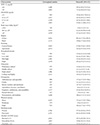1. Natarajan P, Ray KK, Cannon CP. High-density lipoprotein and coronary heart disease: current and future therapies. J Am Coll Cardiol. 2010; 55(13):1283–1299.
2. Riggs KA, Rohatgi A. HDL and reverse cholesterol transport biomarkers. Methodist Debakey Cardiovasc J. 2019; 15(1):39–46.

3. Bardagjy AS, Steinberg FM. Relationship between HDL functional characteristics and cardiovascular health and potential impact of dietary patterns: a narrative review. Nutrients. 2019; 11(6):1231.

4. Brites F, Martin M, Guillas I, Kontush A. Antioxidative activity of high-density lipoprotein (HDL): mechanistic insights into potential clinical benefit. BBA Clin. 2017; 8:66–77.

5. Bikle DD. Extraskeletal actions of vitamin D. Ann N Y Acad Sci. 2016; 1376(1):29–52.

6. Marino R, Misra M. Extra-Skeletal effects of vitamin D. Nutrients. 2019; 11(7):1460.

7. Oberoi D, Mehrotra V, Rawat A. “Vitamin D” as a profile marker for cardiovascular diseases. Ann Card Anaesth. 2019; 22(1):47–50.

8. Sun X, Cao ZB, Tanisawa K, Ito T, Oshima S, Ishimi Y, et al. Associations between the serum 25(OH)D concentration and lipid profiles in Japanese men. J Atheroscler Thromb. 2015; 22(4):355–362.

9. Chaudhuri JR, Mridula KR, Anamika A, Boddu DB, Misra PK, Lingaiah A, et al. Deficiency of 25-hydroxyvitamin d and dyslipidemia in Indian subjects. J Lipids. 2013; 2013:623420.

10. Park JE, Pichiah PBT, Cha YS. Vitamin D and metabolic diseases: growing roles of vitamin D. J Obes Metab Syndr. 2018; 27(4):223–232.

11. Sarmiento-Rubiano LA, Angarita Ruidiaz JA, Suarez Dávila HF, Suarez Rodríguez A, Rebolledo-Cobos RC, Becerra JE. Relationship between serum vitamin D levels and HDL cholesterol in postmenopausal women from Colombian caribbean. J Nutr Metab. 2018; 2018:9638317.

12. Ponda MP, Huang X, Odeh MA, Breslow JL, Kaufman HW. Vitamin D may not improve lipid levels: a serial clinical laboratory data study. Circulation. 2012; 126(3):270–277.
13. Ponda MP, Liang Y, Kim J, Hutt R, Dowd K, Gilleaudeau P, et al. A randomized clinical trial in vitamin D-deficient adults comparing replenishment with oral vitamin D3 with narrow-band UV type B light: effects on cholesterol and the transcriptional profiles of skin and blood. Am J Clin Nutr. 2017; 105(5):1230–1238.
14. Wieder-Huszla S, Jurczak A, Szkup M, Barczak K, Dołęgowska B, Schneider-Matyka D, et al. Relationships between vitamin D3 and metabolic syndrome. Int J Environ Res Public Health. 2019; 16(2):175.
15. Ministry of Health and Welfare, Korea Centers for Disease Control and Prevention. Korea Health Statistics 2010: Korea National Health and Nutrition Examination Survey (KNHANES V-1) [Internet]. Cheongju: Korea Centers for Disease Control and Prevention;2011. Accessed Feb 21, 2019. Available from:
https://knhanes.cdc.go.kr/knhanes/sub03/sub03_02_02.do.
16. Ministry of Health and Welfare, Korea Centers for Disease Control and Prevention. Korea Health Statistics 2011: Korea National Health and Nutrition Examination Survey (KNHANES V-2) [Internet]. Cheongju: Korea Centers for Disease Control and Prevention;2012. Accessed Feb 21, 2019. Available from:
https://knhanes.cdc.go.kr/knhanes/sub03/sub03_02_02.do.
17. Ministry of Health and Welfare, Korea Centers for Disease Control and Prevention. Korea Health Statistics 2012: Korea National Health and Nutrition Examination Survey (KNHANES V-3) [Internet]. Cheongju: Korea Centers for Disease Control and Prevention;2013. Accessed Feb 21, 2019. Available from:
https://knhanes.cdc.go.kr/knhanes/sub03/sub03_02_02.do.
18. Kweon S, Kim Y, Jang MJ, Kim Y, Kim K, Choi S, et al. data resource profile: the Korea National Health and Nutrition Examination Survey (KNHANES). Int J Epidemiol. 2014; 43(1):69–77.

19. Yun YM, Song J, Ji M, Kim JH, Kim Y, Park T, et al. Calibration of high-density lipoprotein cholesterol values from the Korea National Health and Nutrition Examination Survey Data, 2008 to 2015. Ann Lab Med. 2017; 37(1):1–8.

20. Alberti KG, Eckel RH, Grundy SM, Zimmet PZ, Cleeman JI, Donato KA, et al. Harmonizing the metabolic syndrome: a joint interim statement of the International Diabetes Federation Task Force on Epidemiology and Prevention; National Heart, Lung, and Blood Institute; American Heart Association; World Heart Federation; International Atherosclerosis Society; and International Association for the Study of Obesity. Circulation. 2009; 120(16):1640–1645.
21. Bahor TF, Higgins-Biddle JC, Saunders JB, Monterio MG. World Health Organization. AUDIT: the Alcohol Use Disorders Identification Test: guidelines for use in primary health care. 2nd ed. Geneva: World Health Organization;2001.
22. Kim J, Chu SK, Kim K, Moon JR. Alcohol use behaviors and risk of metabolic syndrome in South Korean middle-aged men. BMC Public Health. 2011; 11:489.

23. Wang T, Sun H, Ge H, Liu X, Yu F, Han H, et al. Association between vitamin D and risk of cardiovascular disease in Chinese rural population. PLoS One. 2019; 14(5):e0217311.

24. Wang H, Peng DQ. New insights into the mechanism of low high-density lipoprotein cholesterol in obesity. Lipids Health Dis. 2011; 10:176.

25. Cho KH, Park HJ, Kim SJ, Kim JR. Decrease in HDL-C is associated with age and household income in adults from the Korean National Health and Nutrition Examination Survey 2017: correlation analysis of low HDL-C and poverty. Int J Environ Res Public Health. 2019; 16(18):3329.

26. Králová Lesná I, Suchánek P, Stávek P, Poledne R. May alcohol-induced increase of HDL be considered as atheroprotective? Physiol Res. 2010; 59(3):407–413.
27. Jung IK. Association of Smoking status and high density lipoprotein-cholesterol in males in the fifth Korea National Health and Nutrition Examination Survey. Korean J Health Promot. 2017; 17(4):289–297.

28. Forey BA, Fry JS, Lee PN, Thornton AJ, Coombs KJ. The effect of quitting smoking on HDL-cholesterol - a review based on within-subject changes. Biomark Res. 2013; 1(1):26.

29. Kardassis D, Gafencu A, Zannis VI, Davalos A. Regulation of HDL genes: transcriptional, posttranscriptional, and posttranslational. Handb Exp Pharmacol. 2015; 224:113–179.

30. Gordon DJ, Probstfield JL, Garrison RJ, Neaton JD, Castelli WP, Knoke JD, et al. High-density lipoprotein cholesterol and cardiovascular disease. Four prospective American studies. Circulation. 1989; 79(1):8–15.







 PDF
PDF ePub
ePub Citation
Citation Print
Print





 XML Download
XML Download